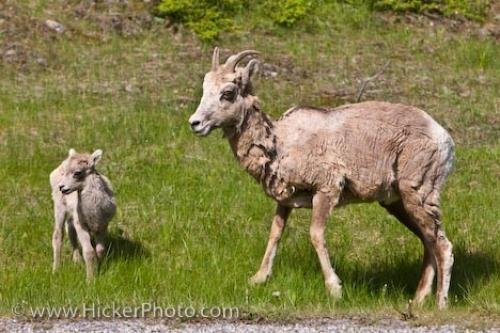Photo: Mountain Animals Bighorn Sheep Lake Banff National Park Alberta
This Bighorn sheep is a species of sheep that is native to North America and Siberia. This species of mountain animal thrives in the alpine regions of Banff and Jasper National Parks in the province of Alberta, Canada.
The Bighorn Sheep is an animal which is completely at home in mountain regions such as in Banff National Park in Alberta, Canada.
It first came over to North America via the Bering Land Bridge - by their millions. However, their population severely declined by 1900, and now, thanks to some conservation steps taken by groups and individuals, their numbers are slowly starting to climb back up.
When a Bighorn ewe is pregnant, they have a six month gestation period, and usually one or at the most two, lambs are born around May; the lambs are heavily dependent on their mother for about four to six months and then they are slowly weaned off their mother's milk and are taught to fend for themselves.
Especially when these sheep are lambs, but even ... continue below the picture...
Mountain Animals Bighorn Sheep Lake Banff National Park Alberta

Pictures from photo gallery "Arctic Animal Pictures"
This picture is part of the photo album "Animal Pictures" - there are more beautiful images waiting for you.
Related stock photo galleries, pictures & travel ideas:
Mountain Animals Bighorn Sheep Lake Banff National Park Alberta
... at any time in their lives, they are very susceptible to diseases that are carried by domestic sheep, and also to accidents such as falling down rocky mountain slopes and both of these factors have contributed to their mortality rate.
They are named Bighorn sheep for the horns that the male rams exhibit, however on females these horns are not as noticeable and there are no horns on the little lambs.
Bighorn ewe and lamb, Ovis canadensis, along the Lake Minnewanka Loop Road, Banff National Park, Alberta, Canada.
Technical Information:
I photographed this photo with the digital SLR camera model Canon EOS-1Ds Mark III, aperture of f/7.1, exposure time of 1/250 sec. on ISO 100, as always I used a original Canon Lens, the focus lenght for this picture was 153mm.
This Bighorn sheep is a species of sheep that is native to North America and Siberia. This species of mountain animal thrives in the alpine regions of Banff and Jasper National Parks in the province of Alberta, Canada.
